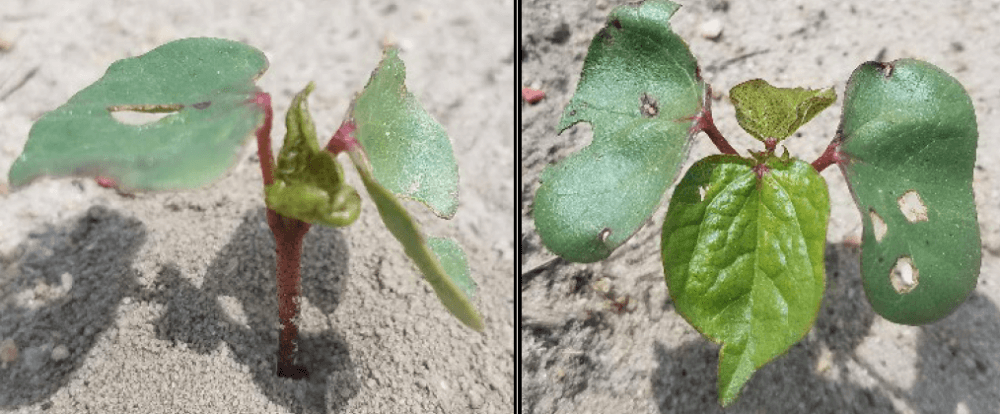
As the 2021 planting season approaches, it’s customary to look back and contemplate what happened last season and the many, many decades of seasons that preceded even last year. Nothing could be more critical than early season pest control, and it starts with nematodes and thrips. The roadmap to harvest begins at planting.
“Like everyone else, we’ve been presenting our 2020 early season pest data for several months now,” says Dr. Scott Graham, Auburn University Assistant Professor and Extension Specialist, Entomology and Plant Pathology.
“We had a mixed bag of weather across Alabama last season,” he says. “Even so, there were some trials that stood out as we look back.”
Thrips, Earliness and Ultimate Yield
“One of our most notable cotton trials in 2020 was at the Prattville Agricultural Research Unit,” Graham says. “The data regarding thrips control was attention grabbing to say the least.”
From early season stand counts, vigor ratings, thrips injury ratings, white bloom counts to ultimate yield, AgLogic aldicarb at 3.5 lbs. per acre lead the entire field of contenders – numerically superior in all measurements, according to Graham.
“That included everything from seed treatments to in-furrow granular and liquid applications and post-emergence treatments,” Graham says. “Looking even further back into the history of aldicarb, that’s not an uncommon result.”
As a newly minted State Extension Specialist at Auburn (start date: April 2020), Graham would have to look back further than his birth date to pull up that information. Conveniently, his long-time predecessor Dr. Ron Smith (retd. Visiting Professor, Auburn University) knows the story well.
“We’ve been looking at aldicarb for more than 40 years,” Smith says. “In some regard, it’s a rare product in that it’s held up for so long with the same consistent results. I’m not the least bit surprised Scott saw the same thing last season.”
Smith had one other comment about the 2020 trials and Graham’s role in reporting University research for growers’ benefit: “We were lucky to get him,” he says. “Auburn has a long history of working for growers, and he hit the ground running his first year even despite the challenges of COVID and getting acquainted with growers across the state.”

Top-of-Mind Regardless of Geography
Further to the east, it’s essentially the same story. Tobacco thrips is a frequent pest of seedling cotton that can reduce lint yield up to 50 percent, according to Dr. Jeremy Greene, Extension and research entomologist and professor at Clemson’s Edisto Research and Education Center (REC). Early planted cotton can be particularly susceptible to thrips damage unless an in-furrow granular or liquid spray is used to mitigate the risk, according to Greene.
By mid-May last season, Greene reported that many at-plant treatments were providing protection, but some weren’t performing at an optimal level. “The plots treated with aldicarb looked the best at early season,” he said.
Aldicarb has been included in Greene’s trials for many years. The product is a constant comparison to multiple early season treatments for thrips control including granular and liquid in-furrow, at-planting options, seed treatments and early foliar treatments.
“Aldicarb always catches your attention,” he says. “It usually leads or is in the top echelon when it comes to thrips control.”
Another factor is earliness. “That one is a little more difficult to quantify except for measurements such as white bloom counts,” Greene says. “But it’s observable and true that the earlier you can establish a canopy, the less problem a grower will have with other agronomic factors such as weeds, and there is a lot to be said for early maturity.”
The Nematode Factor
There are numerous species of nematodes that affect cotton across the Belt. Root-knot (sandier soils) and reniform (heavier clay-type soils) are usually the prime suspects.
AgLogic aldicarb (formerly Temik) has been a contender in research trials for as long as Dr. Kathy Lawrence, Professor of Entomology and Plant Pathology, has been conducting nematode research at Auburn University.
Lawrence routinely evaluates nematicides that include seed treatments (ST), in-furrow (IF) granular and spray products, and pre-harvest sprays (PHS).
In 2020, Lawrence reported the results of a root-knot nematode infested field conducted in central Alabama at the Plant Breeding Unit of Auburn University’s E.V. Smith Research Station Center, Tallahassee, AL. Root-knot pressure was heavy last season at that location, according to Lawrence.
In part, she summarized: “In a comparison of label supported rates the products with highest yields and gross value over the check were recorded with AgLogic 5 lb/A IF ($288 per acre), and Velum Total 14 oz/A IF + Vydate C-LV 17 oz/A PHS ($224 per acre).”
At a reniform nematode infested trial at Auburn’s Tennessee Valley Research and Extension Center near Belle Mina, AL, Lawrence reported the following among evaluated treatments for the 2020 trial:
“AgLogic 5 lb/A ranked first and increased yield by 810 lb/A which at 40% lint and $0.70 cotton would be an additional $228 per acre gross value.”
AgLogic provided the highest numerical yield across the treatments at 3001 pounds of seed cotton per acre.
Conclusions
Although every growing season is different, history often does repeat itself or at least serves as a statistical reference over time, defining the best odds of success.
Whether it’s a fresh new set of eyes or years of experience, University cotton researchers in the Southeast, as well as across the Cotton Belt, continue to provide valuable insight to chart the path forward.